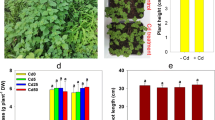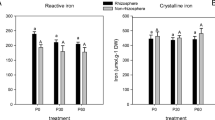Abstract
To evaluate the influence of flavonoids on the biogeochemistry of sulfur in mangrove sediments polluted with Cd, Avicennia marina individuals were cultivated in rhizoboxes under different concentrations of Cd and flavonoid. The reduced inorganic sulfur concentrations in the rhizosphere and non-rhizosphere sediments were examined. According to the results, acid-volatile sulfide concentrations in non-rhizosphere sediments were from 12.77 ± 1.01 to 19.21 ± 0.05 umol/g (DW) and significantly higher than those in rhizosphere, and flavonoids increased acid-volatile sulfide concentrations under Cd stress. High Eh (from 103.00 ± 3.21 to 197.33 ± 14.74 mV) and Cd stress in the rhizosphere led to more elemental sulfur formation, and flavonoid applications significantly increased elemental sulfur in both rhizosphere and non-rhizosphere sediments. Chromium-reducible sulfur from the non-rhizosphere was the source of the Chromium-reducible sulfur in the rhizosphere sediments, in addition to acid-volatile sulfide and elemental sulfur in both rhizosphere and non-rhizosphere sediments. In the rhizosphere with high Eh microenvironments, acid-volatile sulfide could be converted into Chromium-reducible sulfur effectively, while its conversion efficiency was significantly lower in non-rhizosphere. In addition, flavonoid applications reduced acid-volatile sulfide to Chromium-reducible sulfur conversion efficiency. In conclusion, flavonoid treatments in mangrove rhizosphere sediments polluted with Cd increased reduced inorganic sulfur concentrations and influenced sulfur biogeochemistry significantly.






Similar content being viewed by others
References
Allen HE, Gongmin F, Baolin D (1993) Analysis of acid-volatile sulfide (AVS) and simultaneously extracted metals (SEM) for the estimation of potential toxicity in aquatic sediments. Environmental Toxicology and Chemistry 12:1441–1453
Alongi DM (2010) Dissolved iron supply limits early growth of estuarine mangroves. Ecology 91:3229–3241
Anbar AD, Duan Y, Lyons TW, Arnold GL, Kendall B, Creaser RA, Kaufman AJ, Gordon GW, Scott C, Garvin J, Buick R (2007) A whiff of oxygen before the great oxidation event? Science 317:1903–1906
Berner RA (1984) Sedimentary pyrite formation: an update. Geochimica et Cosmochimica Acta 48:605–615
Bo T, Fossing H, Bo BJ (1994) Manganese, iron, and sulfur cycling in a coastal marine sediment, Aarhus Bay, Denmark. Geochimica et Cosmochimica Acta 58:5115–5129
Bottrell SH, Mortimer RJG, Davies IM, Harvey SM, Krom MD (2010) Sulphur cycling in organic-rich marine sediments from a Scottish fjord. Sedimentology 56:1159–1173
Burton ED, Bush RT, Sullivan LA (2006a) Elemental sulfur in drain sediments associated with acid sulfate soils. Applied Geochemistry 21:1240–1247
Burton ED, Bush RT, Sullivan LA (2006b) Fractionation and extractability of sulfur, iron and trace elements in sulfidic sediments. Chemosphere 64:1421–1428
Burton ED, Sullivan LA, Bush RT, Johnston SG, Keene AF (2008) A simple and inexpensive chromium-reducible sulfur method for acid-sulfate soils. Applied Geochemistry 23:2759–2766
Chapman SJ (2001) Sulphur forms in open and afforested areas of two Scottish Peatlands. Water Air and Soil Pollution 128:23–39
Chapman SJ, Davidson MS (2001) S-35-sulphate reduction and transformation in peat. Soil Biology and Biochemistry 33:593–602
Chou CL, Paon LA, Moffatt JD, Buzeta MI, Fenton D, Rutherford RJ (2004) Distribution of contaminants in biota and sediments in the Musquash estuary, Atlantic Canada, marine protected area site initiative and contaminant exclusion zone. Marine Pollution Bulletin 48:884–893
Clark MW, McConchie D, Lewis DW, Saenger P (1998) Redox stratification and heavy metal partitioning in Avicennia-dominated mangrove sediments: a geochemical model. Chemical Geology 149:147–171
Du JN, Yan CL, Li ZD (2013) Formation of iron plaque on mangrove Kandalar. Obovata (SL) root surfaces and its role in cadmium uptake and translocation. Marine Pollution Bulletin 74:105–109
Feijtel TC, Salingar Y, Hordijk CA, Sweerts JPRA, Breemen NV, Cappenberg TE (1989) Sulfur cycling in a dutch moorland pool under elevated atmospheric S-deposition. Water Air and Soil Pollution 44:215–234
Ferreira TO, Otero XL, Vidal-Torrado P, Macias F (2007) Effects of bioturbation by root and crab activity on iron and sulfur biogeochemistry in mangrove substrate. Geoderma 142:36–46
Ferreira TO, Otero XL, Souza VS, Vidal-Torrado P, Macias F, Firme LP (2010) Spatial patterns of soil attributes and components in a mangrove system in Southeast Brazil (Sao Paulo). Journal of Soils Sediments 10:995–1006
Gagnon C, Mucci A (1995) Pelletier anomalous accumulation of acid-volatile sulphides (AVS) in a coastal marine sediment, Saguenay Fjord, Canada. Geochimica et Cosmochimica Acta 59:2663–2675
Howarth RW, Bo BJ (1984) Formation of 35 S-labelled elemental sulfur and pyrite in coastal marine sediments (Limfjorden and Kysing Fjord, Denmark) during short-term 35 SO 4 2− reduction measurements. Geochimica et Cosmochimica Acta 48:1807–1818
Hutchison KJ, Hesterberg D, Chou JW (2001) Stability of reduced organic sulfur in humic acid as affected by aeration and pH. Soil Science Society of America Journal 65:704–709
Jorgensen B (1982) Mineralization of organic matter in the sea bed-the role of sulphate reduction. Nature 296:643–645
Karlsson T, Skyllberg U (2007) Complexation of zinc in organic soils - EXAFS evidence for sulfur associations. Environmental Science and Technology 41:119–124
Kostka JE, Luther GW (1995) Seasonal cycling of Fe in salt-marsh sediments. Biogeochemistry 29:159–181
Kristensen E, Bouillon S, Dittmar T, Marchand C (2008) Organic carbon dynamics in mangrove ecosystems: a review. Aquatic Botany 89:201–219
Li J, Lu H, Liu J, Hong H, Yan C (2015) The influence of flavonoid amendment on the absorption of cadmium in Avicennia marina roots. Ecotoxicology and Environmental Safety 120:1–6
Li J, Liu J, Lu H, Jia H, Yu J, Hong H, Yan C (2016) Influence of the phenols on the biogeochemical behavior of cadmium in the mangrove sediment. Chemosphere 144:2206–2213
Li J, Yu J, Liu J, Yan C, Lu H, Kate LS (2017) The effects of sulfur amendments on the geochemistry of sulfur, phosphorus and iron in the mangrove plant (Kandelia obovata (S. L.)) rhizosphere. Marine Pollution Bulletin 114:733–741
Li YY, Feng WL, Chi HC, Huang YX, Ruan DS, Chao YQ, Qiu RL, Wang SZ (2019) Could the rhizoplane biofilm of wetland plants lead to rhizospheric heavy metal precipitation and iron-sulfur cycle termination? J. Soils Sediments 19:3760–3772
Liu JC, Yan CL, Spencer KL, Zhang RF, Lu HL (2010) The distribution of acid-volatile sulfide and simultaneously extracted metals in sediments from a mangrove forest and adjacent mudflat in Zhangjiang estuary, China. Marine Pollution Bulletin 60:1209–1216
MacFarlane GR, Pulkownik A, Burchett MD (2003) Accumulation and distribution of heavy metals in the grey mangrove, Avicennia marina (Forsk.)Vierh.: biological indication potential. Environmental Pollution 123:139–151
Middelburg JJ (1991) Organic carbon, Sulphur, and iron in recent semi-euxinic sediments of Kau Bay, Indonesia. Geochimica et Cosmochimica Acta 55:815–828
Morse JW, David R (2004) Chemical dynamics of sedimentary acid volatile sulfide. Environmental Science and Technology 38:131A
Rickard D, Morse JW (2005) Acid volatile sulfide (AVS). Marine Chemistry 97:141–197
Rickards D, Mussmann M, Steadman JA (2017) Sedimentary sulfides. Elements 13:117–122
Roden EE, Turtle JH (1993) Inorganic sulfur cycling in mid and lower Chesapeake Bay sediments. Marine Ecology Progress 93:101–118
Sheng Y, Sun Q, Bottrell SH, Mortimer RJG, Shi W (2013) Anthropogenic impacts on reduced inorganic sulfur and heavy metals in coastal surface sediments, North Yellow Sea. Environmental Earth Sciences 68:1367–1374
Silva C, Silva AP, Oliveira SR (2006) Concentration, stock and transport rate of heavy metals in a tropical red mangrove, Natal, Brazil. Marine Chemistry 99:2–11
Sullivan LA, Bush RT, Mcconchie D, Lancaster G, Haskins PG, Clark MW (1999) Comparison of peroxide-oxidisable sulfur and chromium-reducible sulfur methods for determination of reduced inorganic sulfur in soil. Australian Journal of Soil Research 37:255–265
Sullivan LA, Bush RT, McConchie DM (2000) A modified chromium-reducible sulfur method for reduced inorganic sulfur: optimum reaction time for acid sulfate soil. Australian Journal of Soil Research 38:729–734
Tam NFY, Wong YS (1997) Accumulation and distribution of heavy metals in a simulated mangrove system treated with sewage. Hydrobiologia 352:67–75
Tao F, Xiangdong L, Gan Z (2005) Acid volatile sulfide and simultaneously extracted metals in the sediment cores of the Pearl River estuary, South China. Ecotoxicology & Environmental Safety 61:420–431
Wong VNL, Cheetham MD, Bush RT, Sullivan LA, Ward NJ (2016) Accumulation of sulfidic sediments in a channelised inland river system, southern Australia. Marine and Freshwater Research 67:1655–1666
Wu SJ, Li RL, Xie SG, Shi C (2019) Depth-related change of sulfate-reducing bacteria community in mangrove sediments: the influence of heavy metal contamination. Marine Pollution Bulletin 140:443–450
Acknowledgments
This work was jointly funded by National Natural Science Foundation of China (31800429), Natural Science Foundation of Jiangsu Province (BK20170540) and the Applied Technology Research and Development Program of Heilongjiang(GA19B104-2). The authors would like to thank Xuexue Yang for her effort in manuscript improvement.
Author information
Authors and Affiliations
Corresponding author
Ethics declarations
Conflict of Interest
All the authors declare that there is no conflict of interest.
Ethical Approval
This article does not contain any studies with animals performed by any of the authors.
Additional information
Publisher’s Note
Springer Nature remains neutral with regard to jurisdictional claims in published maps and institutional affiliations.
Rights and permissions
About this article
Cite this article
Youli, Z., Jian, L., Zhanrui, L. et al. The Influence of Root Exudate Flavonoids on Sulfur Species Distribution in Mangrove Sediments Polluted with Cadmium. Wetlands 40, 2671–2678 (2020). https://doi.org/10.1007/s13157-020-01298-1
Received:
Accepted:
Published:
Issue Date:
DOI: https://doi.org/10.1007/s13157-020-01298-1




